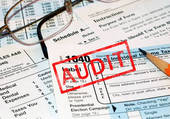TIGTA issued its report Reference Number: 2020-30-031 on June 22, 2020 to the Commissioner of Internal Revenue.
The IRS’s primary objective in selecting returns for examination is to promote the highest degree of voluntary compliance. The LB&I Division has a variety of examination programs and uses a multitude of methods to select returns. However, it consistently spent most of its examination resources on large business returns.
The IRS compiles Tax Gap data to periodically update appraisals of the nature and extent of tax payment noncompliance for use in formulating tax administration strategies.
Tax Years 2011 Through 2013 To Be $411 Billion.
The largest component, $352 billion, is attributable to underreporting of taxes. Large corporation (assets of $10 million or more) tax noncompliance contributes an estimated $26 billion to the average annual underreporting Tax Gap.
This audit was initiated to evaluate the selection process, use of resources, and examination productivity for corporate returns examined as part of the Large Business and International (LB&I) Division’s Discriminant Analysis System (DAS) workstream. Approximately 44 percent of Form 1120, U.S. Corporation Income Tax Return, examinations during Fiscal Years 2015 through 2018 were closed from the DAS workstream. If
TIGTA Analyzed The 10,755 Returns Closed in the DAS Workstream During Fiscal Years 2015 Through 2018
and Found That 47 Percent Were Closed
With No Change to the Tax Return.
TIGTA analyzed the potential cost for excessive time charged to no-change returns, i.e., time in excess of 200 hours, and estimated that potentially $22.7 million was spent examining no‑change returns in excess of 200 hours.
Of the 10,755 returns:
- 7,831 returns (73 percent) were systemically selected, i.e., were selected as the primary tax return to be examined.
- The overall no-change rate for these returns was about 55 percent (4,327 of the 7,831), and
- The no‑change rate was generally high across all activity codes for businesses with assets of $10 million or more (ranging from 44 percent to 61 percent).
The LB&I Division is updating the DAS model to improve the no‑change rates. However, TIGTA found that the LB&I Division is not leveraging all available information to improve the model, such as the examination scope and which tax issues are the most productive to examine. LB&I also plans to test the new formulas only on returns that are nearly a decade old.
TIGTA Reviewed The Examination Results For The 10,755 DAS Returns and Found That the LB&I Division
Is Not Adequately Monitoring DAS Examination Results
To Assess Whether The Model Is Effectively Ranking Returns
Based On The Likelihood of Potential Tax Adjustment.
When assessing the productivity of its models, the LB&I Division does not use the actual examination amount when an examination results in a refund. Instead, it treats examinations that result in a refund as no change in tax. By not using the actual examination amount for refunds, the LB&I Division’s productivity is skewed to the positive and does not accurately reflect the true compliance impact.
TIGTA recommended that the LB&I Division:
- Develop an action plan to reduce the examination no-change rates;
- Avoid working pickup returns unless issues are established on primary tax returns that may affect prior or subsequent years;
- Minimize hours expended on no‑change closures;
- Test newly developed formulas on current examined returns;
- Consider breadth of scope and noncompliance issues found in past examinations; and
- Analyze DAS return actual examination results on a regular basis.
The LB&I Division agreed with two recommendations and will formulate a plan to reduce the no‑change rate and hours incurred. The LB&I Division also plans to analyze examination results on a regular basis.
The LB&I Division disagreed with three recommendations pertaining to the DAS model and noted that it released a new DAS model in April 2020. The LB&I Division also disagreed with using actual examination dollar results for evaluating the effectiveness of the DAS model.
To view the report, including the scope, methodology, and full IRS response, go to: https://www.treasury.gov/tigta/auditreports/2020reports/202030031fr.pdf.
Have a Tax Problem?
Contact the Tax Lawyers at
Marini & Associates, P.A.
for a FREE Tax HELP Contact us at:
www.TaxAid.com or www.OVDPLaw.com
or Toll Free at 888-8TaxAid
Read more at: Tax Times blog






